Mark James E. (ed.). Physical Properties of Polymers Handbook
Подождите немного. Документ загружается.


CHAPTER 60
Acoustic Properties of Polymers
Moitreyee Sinha and Donald J. Buckley
General Electric Global Research Center, One Research Circle, Niskayuna, NY 12309
60.1 Introduction . ............................................................. 1021
60.2 Low Frequencies.......................................................... 1022
60.3 Ultrasonic Frequencies .................................................... 1024
60.4 Hypersonic (GHz) Frequencies ............................................. 1028
60.5 Concluding Remarks ...................................................... 1030
Acknowledgments ........................................................ 1030
References . . ............................................................. 1031
60.1 INTRODUCTION
The measurement of acoustic properties of polymers,
longitudinal and shear sound speeds and absorption, probe
the molecular structure of polymers as well as provide a
source of engineering design properties for various applica-
tions [1]. The term acoustic refers to a periodic pressure
wave. The term includes waves in the audio frequency range
(those that can be heard by the human ear) as well as those
above the audio range (ultrasonic and hypersonic) and
below the audio range. Acoustic waves are characterized
by their sound speed and sound absorption. The sound speed
C is the scalar magnitude of the sound velocity vector and
has units of m/s. Sound absorption a is a measure of the
energy removed from the sound wave by conversion to heat
as the wave propagates through a given thickness of mater-
ial. Absorption has units of dB/cm, where a dB (decibel) is a
unit based on ten times the common logarithm of the ratio of
two acoustic energies. Alternatively, the natural logarithm
can be used, in which case the units are Np/cm, where 1 Np
(neper) is equal to 8.686 dB. It is sometimes convenient to
consider the amount of absorption in a thickness equal to
one wavelength, l. The quantity al then has units of dB (or
Np). Absorption is a material property, in contrast to attenu-
ation, which includes energy loss due to scattering and
reflection as well as absorption and depends on sample
size and experimental configuration.
In an unbounded isotropic solid, two types of waves can
be propagated. In one case, the chain segments vibrate along
the direction of propagation. This is called a longitudinal
wave. In the other case, the motion of the segments is
perpendicular to the direction of propagation and is called
a shear wave. Longitudinal waves are also sometimes re-
ferred to as dilatational, compressional, or irrotational
waves. Shear waves are also called distortional, isovolumi-
nous, or transverse waves. These two types of waves propa-
gate independently of one another and are the only two types
possible in an unbounded, isotropic solid. The longitudinal
and transverse sound speeds are related to the elastic con-
stants by the relations
n
l
¼
ffiffiffiffiffiffiffiffiffiffiffiffiffiffiffiffiffiffiffiffi
K þ 4G=3
r
s
,
n
s
¼
ffiffiffiffi
G
r
s
,
(60:1)
where K is the bulk modulus (equal to the reciprocal of
compression), G the shear modulus, and r the density.
For a sample whose lateral dimensions are much less than
a wavelength, an extensional wave is propagated. For such a
wave, the sound speed is
v
EXT
¼
ffiffiffiffiffiffiffiffi
E=r
p
, (60:2)
where E is Young’s modulus. As mentioned earlier, there
are only two independent sound speeds, and the extensional
sound speed can be expressed in terms of the longitudinal
and shear sound speeds. It is common to express Young’s
modulus as a complex quantity, E
¼ E
0
þ iE
00
. The ratio of
the imaginary part of the modulus (Young’s shear of bulk) to
1021
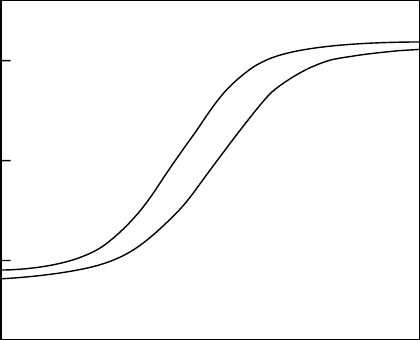
the real part is the tangent of the phase angle between the
two components and is called the loss factor, tan d. The loss
factor is approximately related to absorption per wavelength
by the equation
tan d ¼ E
00
=E
0
¼ al=p (60:3)
in units of Nepers (Np). Other types of waves include
surface waves and bulk waves but such waves will not be
discussed here.
In viscoelastic materials such as polymers the moduli
depend on frequency. Physically, the amount of deformation
that is produced in a polymer by a given stress depends on
the length of time that the stress is applied. In typical high
frequency measurements (ultrasonic or Brillouin), during
the short time that the stress of a sound wave is applied in
one direction, only relatively small portions of the polymer
can move; hence not as much strain is induced as in typical
static or low frequency measurements, and the high fre-
quency modulus is higher than the static modulus. Another
way of looking at it is that for high frequency measurements,
the time scales are so short that the distances over which the
chains can relax are very short. For ultrasonic measure-
ments, this effect is not too pronounced for the bulk modulus
(on the order of 20%), but can be significant for shear and
Young’s modulus (a factor of 10 or more).
Because of the above dependence on frequency, sound
waves represent a mechanical probe for particular wave
motions, namely, motion that can occur in the period of
the sound wave. Viewed as one technique for making mech-
anical measurements on polymers, sound wave measure-
ments using ultrasonic or Brillouin scattering probe
motions of the polymer on short length scales while methods
such as audio or low frequency DMA measurements probe
large-scale motions.
The different experimental methods for sound wave
propagation and for measuring the mechanical response or
elastic constants of polymers are summarized below with an
attempt to give an idea of the different time scales involved.
Audio or ultralow frequency DMA (dynamic mechanical
analysis) measurements:
1 Hz–20 kHz.
Ultrasonic experiments: 1 kHz–1 GHz.
Brillouin light scattering at hypersonic frequencies:
0.1–100 GHz.
At high frequencies (higher than 1 MHz), there is no
direct way to measure the modulus by applying known
values of stress and measuring the strain. At these frequen-
cies, the elastic constants for polymers are calculated from
sound velocity measurements using ultrasonic or Brillouin
light scattering experiments. In this review, we will largely
focus on measurements at ultrasonic frequencies. For elasto-
meric networks we will briefly review sound wave meas-
urements reported at very low frequencies and at very high
(GHz) frequencies.
The propagation of a sound wave is fundamentally a
molecular process, and the interaction between elastic
wave propagation and molecular behavior has a significant
effect on sound dispersion and attenuation, particularly at
ultrasonic frequencies. If a sound wave in a fluid disturbs
any particular equilibrium molecular aggregation, it takes
a certain time t, called the relaxation time, for the original
state to be restored after the passage of the crest of the wave.
The process is usually called thermal relaxation.
As is well known for viscoelastic materials, the frequency
and temperature dependencies of polymer properties are
related. For groups of relaxation processes that encompass a
very broad time range, it often happens that the experimen-
tally limited frequency range is not large enough to obtain a
complete curve. Using the time–temperature superposition
principle, measurements carried out at a sequence of different
temperatures can provide the missing information to generate
the frequency-dependent curve as shown in Fig. 60.1 [2].
60.2 LOW FREQUENCIES
At the lower frequency end (less than 20 kHz), there have
been some earlier studies on sound or pulse propagation in
rubbery polymers. Some related work on natural and butyl
rubber is discussed below.
Witte et al. reported velocity and attenuation measure-
ments in thin strips of butyl rubber from 0.5 to 5 kHz (audio
frequency) at different temperatures [3]. They found the
speed of sound to increase with decreasing temperature
and increasing frequency. The attenuation showed a peak
with temperature. The experimental procedure made use of
a signal generator for driving a crystal, setting up longitu-
dinal waves which were transmitted through the sample and
picked up by a crystal receiving element. Thus it was pos-
sible to determine the phase difference between the driven
end and the pickup for any point along the sample. By
or
log E (dyn/cm
2
)
Rubber
Plastic
1
2
T
1
T
2
3
6
8
10
1/T log f
FIGURE 60.1. Rubber to glass transition at two temperatures
(T
1
< T
2
) [2]. Reprinted with permission from J. D. Ferry,
Viscoelastic Properties of Polymers, 3rd ed. (1980). Copyright
1980, Wiley.
1022 / CHAPTER 60
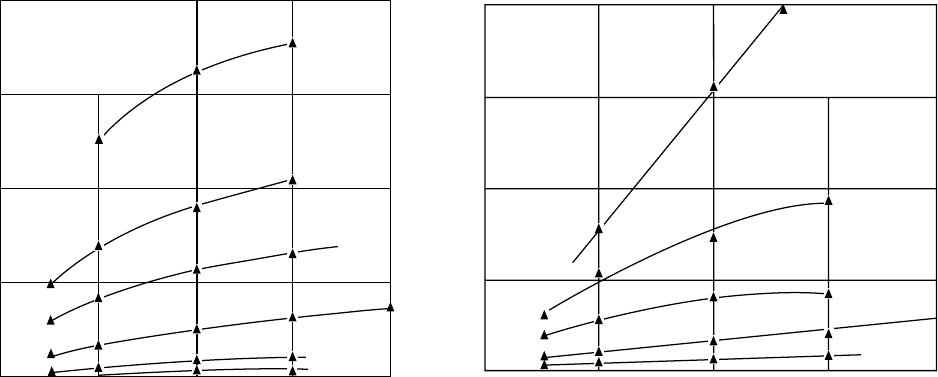
moving the pickup along the sample, the distance between
two adjacent points in the same phase of motion were
measured, and thus the wavelength of the sound wave in
the sample could be determined. Knowing the frequency of
the driving oscillator, the velocity was directly obtained.
The attenuation was obtained by moving the pickup along
the sample and reading on the wave analyzer, the amplitude
of the received signal as a function of distance. This method
of measurement is limited to a definite frequency range; an
upper limit to the frequency range is determined by the fact
that the largest cross-sectional dimension of the sample had
to be kept small in comparison with the wavelength of the
propagated wave. At sufficiently low frequencies, the sam-
ple length became smaller than the half-wavelength of the
transmitted sound wave making velocity measurements im-
possible.
Figure 60.2 shows the velocity curves of butyl rubber as
a function of frequency at different temperatures. The vel-
ocity increases very slowly with frequency at high temper-
atures where the values of the velocity are of the order of
40 m/s. The increase in velocity with frequency is much
more rapid as the temperature is lowered, and at 0 8C the
velocity is about 300 m/s. The corresponding modulus
curves derived from the velocity curves is shown in Fig.
60.2. At all temperatures the modulus was seen to increase
with frequency. From ultrasonic experiments on the same
polymers, the data obtained at frequencies in the MHz range
indicated a continuous rise in the modulus with frequency
(measured up to 15 MHz). The dispersion over a limited
frequency range can be attributed to a mechanism involving
relaxation times of the order of 1=v, whereas the entire
dispersion range would have to be explained on the assump-
tion of a wide distribution of relaxation times. The relax-
ation mechanism for these low frequency measurements
responsible for the dispersion would involve the assumption
of a number of relaxation times of the order of 10
3
s. Also
from their results they found that an increase in temperature
produced the same effect as a decrease in frequency. This
supports the time–temperature superposition principle for
viscoelastic materials.
Gent and Marteny [4] measured the difference in time for
loading and unloading pulses to reach two phonograph
pickups, placed a known distance apart, to determine the
velocity of sound as a function of strain in filled and unfilled
natural rubber. For both cases they found a marked increase
in the speed of sound with imposed strain. For the unfilled
rubber, the sound velocity increased from about 60 m/s at
zero strain up to about 600 m/s at high strains (about four
times the original length) (Fig. 60.3). For the filled rubber,
the speed was about 160 m/s at zero strain and reached
about 800 m/s at high strains.
Although wave propagation techniques have been used
extensively to study the bulk properties of polymers, their
application in understanding the microscopic structure of
networks has been limited. Most of the studies have been
directed toward studying the change in sound velocity with
temperature and frequency, or toward the determination of
various bulk properties such as the modulus, hysteresis,
absorption, etc. of networks. The nonlinear nature of the
elastic material carrying the disturbance has been treated in
a phenomenological manner. Sinha et al. measured the
speeds of longitudinal and transverse pulses in uniaxially
stretched siloxane (PDMS) networks as a function of the
extension ratio, the degree of crosslinking and the amount of
swelling [5]. They used a theoretical framework combining
the theory of elastic wave propagation and molecular
models for the networks to determine network parameters
from measurements of the wave velocity in deformed
0
40
120
Velocity in m/s
200
280
360
12
Frequency in kc
Frequency in kc
0
10
110
210
Modulus in MB/cm
2
310
410
123
66.5
°c
41.0
°c
22.0
°c
12.5 °c
1.0
°c
4
3
90.0
°c
66.5
°c
41.0
°c
22.0
°c
12.5
°c
10
°c
4
FIGURE 60.2. Velocity versus frequency for butyl rubber. The dynamic Young’s modulus as a function of frequency for butyl
rubber [3]. Reprinted with permission from R.S. Witte, B.A. Mrowca, and E. Guth, Journal of Applied Physics, 20, 481 (1949).
Copyright 1949, American Institute of Physics.
ACOUSTIC PROPERTIES OF POLYMERS / 1023
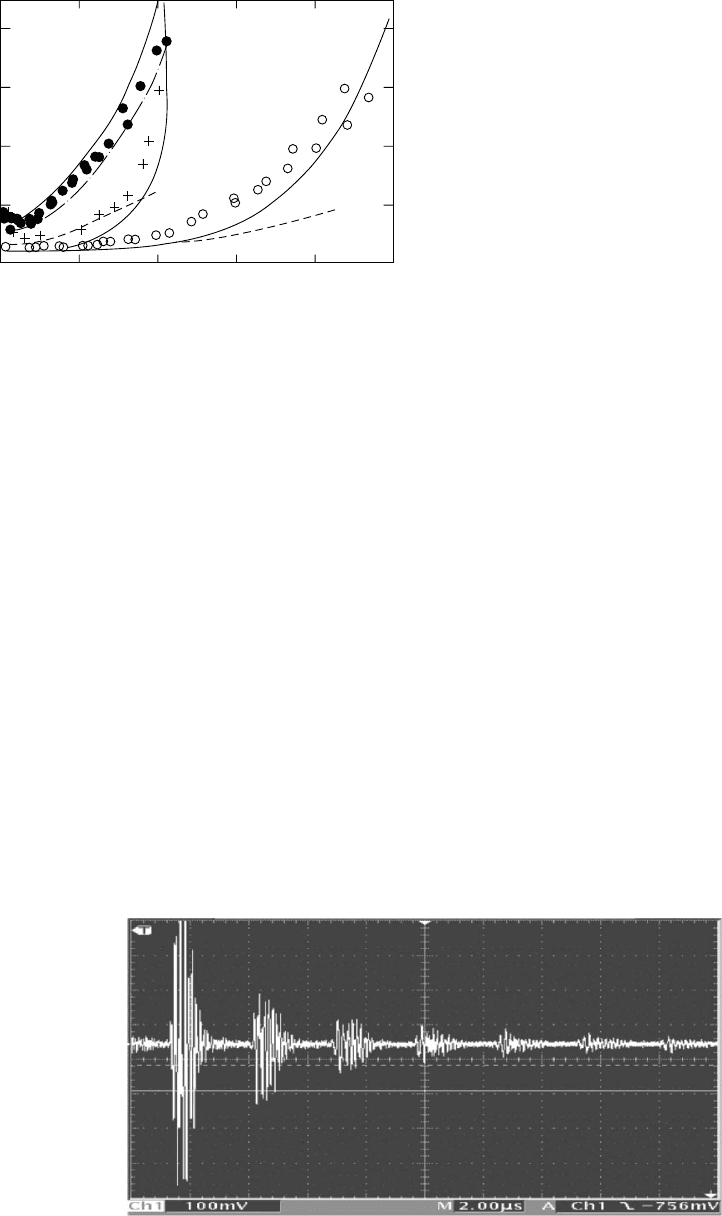
networks. From ultrasonic measurements on PDMS [6], the
values reported for the longitudinal speed is 1,020 m/s using
an immersion measurement technique based on measuring
the differences between acoustic paths with and without the
specimen. This corresponds to a longitudinal elastic modu-
lus of 1.087 GPa, about 10
4
times higher than the equilib-
rium modulus.
60.3 ULTRASONIC FREQUENCIES
60.3.1 Ultrasonic Material Properties
The term ultrasound in its broadest sense covers all sound
with frequencies greater than the audible range. In general
use, however, the term is restricted to frequencies of 1 MHz
and greater, up to the point where phonon processes, such as
Brillouin scattering, become important.
Ultrasonic investigations are often performed using the
immersion technique where the sample and transducer
(a combined transmitter and receiver of ultrasonic radiation)
are immersed in a liquid, typically water, although other
fluids such as silicone oil may be used. The fluid supplies
efficient coupling of ultrasonic energy between the output
lens of the transducer, which is typically a hard thermoplas-
tic such as polystyrene, and the sample. In another arrange-
ment, energy is coupled directly to the sample in that a pulse
propagates from the transducer through a thin layer of coup-
ling medium (usually soapy water to assure good wetting of
the polymer surface) into a plane polymer sample.
Both methods use the pulse–echo technique. A pulse is
sent into the sample, where it is reflected by the front and
back surfaces of the material and returned at reduced amp-
litude to the transducer, while the waveforms are monitored
on a recording oscilloscope. From the timing and amplitude
of the reflected waves the sound speed and attenuation of the
material may be determined. Successive reflections provide
additional information on both these properties. A typical
ultrasound pattern obtained using the direct-coupled trans-
ducer method is shown in Fig. 60.4.
Normal Incidence
The longitudinal sound speed in the polymer can be
determined by measuring the time required for a pulse
propagated normally into the sample to reflect from its far
surface (usually a polymer/air interface where the imped-
ance mismatch generates a reflected wave), and dividing the
sample’s thickness by twice this time. The time is deter-
mined by the interval between the initial pulse and the
successive reflections, which result as the wave bounces
200
0
0123
Strain e
45
400
(m/s)
Velocity
V
s
600
800
Not prestretched
Prestretched
to e=2.14
BA
FIGURE 60.3. Velocity of sound for unfilled rubber (open
circles) and in carbon-black filled rubber (filled circles); Vel-
ocity in filled rubber after prestretching to a strain value of 2.14
(crosses). Full curves: calculated from values of the instant-
aneous modulus obtained from unloading stress–strain rela-
tions. Broken curves: calculated using loading stress–strain
relations. Chain curve: calculated using loading-after-resting
stress–strain relations [4]. Reprinted with permission from
A.N. Gent and P. Marteny, Journal of Applied Physics, 53,
6069 (1982). Copyright 1982, American Institute of Physics.
FIGURE 60.4. Ultrasound pulse–echo pattern obtained at 10 MHz in a polystyrene disk 3 mm thick. The interval between
successive reflections indicates the velocity of the longitudinal wave, and the ratio of intensity of any two successive reflections
the attenuation. The horizontal scale is 2:00 ms/division. In this material the (longitudinal) speed of sound is 2.14 km/s, the acoustic
impedance is 2.25 MRayls (units of 10
6
kg=(cm
2
-s) and the attenuation coefficient is ca. 12 db/cm. See text below for the
calculation [57].
1024 / CHAPTER 60
off the water/plastic interface repeatedly. The velocity is
then
C
L
¼ 2d=t: (60:4)
In the example in Fig. 60.4, d ¼ 3 mm, t ¼ 2:8 ms, and C
L
is
2:14 mm=ms or 2.14 km/s.
From the same trace, the longitudinal absorption coeffi-
cient can be determined by observing the peak height in
successive reflected pulses. The attenuation per unit length
is usually expressed on a logarithmic scale in units of
decibels/cm (abbreviated dB/cm), where the decibel repre-
sents a reduction in power of 1.258 times. The attenuation is
then:
a(dB=cm) ¼ 10=L log (I
initial
=I
final
) (60:5)
or, in terms of the voltages (signal amplitudes) displayed on
an oscilloscope,
a ¼ 20=L log (V
initial
=V
final
), (60:6)
where V
initial
is the pulse height going in, V
final
the height
coming out, and L the path length in the sample, equal to
twice the thickness.
In addition to attenuation within the sample, there are
losses from reflection at the sample/air and sample/coupling
medium interfaces, and losses in transversing the coupling.
The latter are small in the direct-coupled technique, but can
be significant in the immersion tank method. The former can
be significant to the extent of mismatch of the acoustic
impedances of the two media. The acoustic impedance Z,
a quantity analogous to the electrical impedance, is the
product of the sound velocity and the density, expressed in
units of megaRayls, MRayls or 10
6
kg=(s m
2
). For example,
the impedance mismatch of polystyrene (Z¼2.5 and a ma-
terial often used for transducer lensing) with water (Z¼1.5)
results in a portion of the incident beam being reflected, that
portion having amplitude:
R
PS--- Water
¼ [(Z
PS
Z
Water
)=(Z
PS
þ Z
Water
)]
¼ [(2:5 1:5)=(2:5 þ1:5)] ¼ 0:25 (60:7)
and the reflected intensity is
R
2
PS
--- Water
¼ [0:25]
2
¼ :064: (60:8)
The equivalent calculation for the air/polystyrene interface
gives
R
2
PS
--- Air
¼ 0:186: (60:9)
Generally, sound velocities are much more readily and
accurately measured than absorption coefficients, since only
time differences are required for the former, while measure-
ment of the latter are influenced by many artifacts, such as the
reproducibility of the coupling, beam spread and dispersion.
Oblique Incidence
When the transducer beam is not normal to the sample
surface, both longitudinal and shear waves are generated.
The longitudinal wave may be eliminated by increasing the
incident angle until total internal reflection of this compon-
ent occurs, at the critical angle given by Snell’s law,
sin u
P
=C
P
¼ sin u
m
=C
m
, (60:10)
where the medium (m) of the incident wave is often a prism
of polystyrene or polymethylmethacrylate (PMMA). For
a polystyrene prism with C
P
¼ 2:4m=s, propagating into a
PMMA slab with C
P
¼ 2:7m=s the critical angle is approxi-
mately 51 8.
Owing to the non-normal incidence, measurement of the
shear wave velocity C
s
requires a separate transmitter and
receiver. The path length in the specimen is given by [43]:
x ¼ L[1 [C
s
sin uC
2
m
]
1=2
(60:11)
and the shear velocity C
s
by [43]:
C
s
¼ C
m
{[ cos
~
uuC
m
Dt=L]
2
þ sin
2
u}
1=2
: (60:12)
Shear and Bulk Moduli
Ultrasound can also be used to determine the elastic
moduli of materials, with the modulus of interest determined
by the mode of propagation: longitudinal (sound waves
producing motion of sample’s atoms parallel to the direction
propagation), shear (excitation at right angles to the direc-
tion of propagation) and extensional (longitudinal excitation
in the sample with lateral dimensions small compared to the
ultrasonic wavelength).
The speed of sound C for a given propagation mode is
related to the corresponding modulus M and the density r by
the general relation [2]
rC
2
¼ M: (60:13)
For a longitudinal and shear waves, respectively, the
relations are [43]:
Longitudinal: rC
2
Longitudinal
¼ K þ 4=3G, Shear:
rC
2
Shear
¼ G,
(60:14)
where K and G are the bulk and shear moduli, respectively.
At low frequencies, where the wavelength can be greater
than the lateral dimension of the sample, there is a third
mode, extension, where the relation is
rC
2
Extensional
¼ E (60:15)
with E being the Young’s modulus. Typical sound velocities
in materials are or order 2---5 10
2
for gases, 1---3 10
3
for
organic solids, and 3---6 10
3
for dense crystalline solids.
The frequencies of interest for applied ultrasound are in
the range 1–100 MHz, corresponding to wavelengths of
2–0.02 mm when propagating in polystyrene. The shear
velocities are typically (1/3)–(1/2) those in the longitudinal
mode.
Longitudinal waves may be generated using a piezo-
electric transducer activated by an RF pulse train of the
ACOUSTIC PROPERTIES OF POLYMERS / 1025

appropriate frequency, with the transducer coupled at nor-
mal incidence to the sample surface. Shear and longitudinal
waves can be generated in a sample using the same equip-
ment but with the transducer face oriented at angle from
normal using a plastic coupling wedge.
Tables 60.1 and 60.2 list values of the longitudinal and
shear velocities at 1 MHz, and attenuations at 2 MHz at
room temperature for some common polymers [2].
Temperature, Frequency and Pressure Dependence
of Ultrasonic Properties
The largest change in acoustic properties of a polymer
occurs across T
g
, when the material transitions from a hard
glassy solid to the rubbery plateau. Above this temperature
the moduli and sound speeds drop (a rule of thumb for the
latter is that it decreases by a factor of 2) while the absorp-
tion increases by an order of magnitude or more, with a
maximum some distance above T
g
. The temperature deriva-
tives are maximum around T
g
and are of order 25 m/s/K [2].
Since there is a time–temperature superposition for poly-
mers, the frequency and temperature dependences of the
acoustic properties are inversely related, so that decrease
in temperature correspond to the effect of increases in
frequency. This behavior is illustrated by comparing Fig.
60.5(a) and (b) which display the temperature and frequency
sensitivity for two polymers [1]. Since measurements over
a wide temperature range are more readily made than those
over a corresponding frequency range, the combination of
the data from measurements over a wide temperature range
and a modest frequency range usually serve to define the
entire spectrum. The frequency sensitivity of ultrasound
velocities is weak, of order 5–10 m/s/decade [2]. The at-
tenuation, however, is strongly dependent, increasing at
least linearly and often as the square of frequency, and is
of order 20–100 dB/cm/decade. For example, over the range
4–6 MHz, the speed of longitudinal sound in PMMA
changes by only 1%, [52] while the attenuation increases
from 40 to 60 Nps/m. Both velocity and attenuation are
sensitive functions of temperature, with velocity decreasing
across T
g
to ca. 1/2 its low temperature plateau value, while
attenuation peaks at or near T
g
.
The pressure derivative of the sound speeds are inversely
related to temperature since a pressure change results in a
change in free volume. Few pressure derivatives have been
measured; typical values are of 0.5–0.9 GPa
1
.
49.3.2 Applications of Ultrasound for Polymers
Acoustic Dynamic Mechanical Analysis (DMA)
At acoustic frequencies, the attenuation goes through a
maximum determined by the spectrum of relaxation times in
the polymer; hence dynamical mechanical analysis can be
performed by scanning over a wide frequency range, typic-
ally 10
3
10
12
Hz. An example of the technique is sonic
DMA of PVC [54] which shows that the shear modulus
increase monotonically with frequency, while the longitu-
dinal or extensional modulus displays the transition associ-
ated with T
b
. The ratio of the loss and storage moduli, or tan
delta obtained via DMA can be related to the absorption
coefficient through the equation [2]:
a ¼ Pl tan d ¼ PlE
00
=E
0
: (60:16)
TABLE 60.1. Longitudinal and shear velocities for common polymers at 25 8C and 1 MHz [1].
Acronym Poly- Density (g=cm
3
) C
L
(m/s) C
s
(m/s) References
ABS acrylonitrile–butadiene–styrene 1.041 2,160 930 [30]
Epoxy DGEBA/PDA 1.184 2,890 1,290 [34]
Nylon hexamethylene adipamide 1.147 2,710 1,120 [6]
PC carbonate 1.194 2,220 909 [28]
PE ethylene 0.957 2,430 950 [6]
PEO ethylene oxide 1.208 2,250 — [6]
PES ether sulfone 1.373 2,260 — [29]
Phenolic 1.220 2,840 1,320 [25]
PMMA methylmethacrylate 1.191 2,690 1,340 [6]
PMP methyl pentene 0.835 2,180 1,080 [30]
POM oxymethylene 1.425 2,440 1,000 [6]
PP propylene 0.913 2,650 1,300 [6]
PPO phenylene oxide 1.073 2,220 1,000 [28]
PS styrene 1.052 2,400 1,150 [6]
PSU sulfone 1.236 2,260 920 [28]
PVC vinyl chloride 1.386 2,330 1,070 [29]
PVDF vinylidene fluoride 1.779 1,930 775 [6]
Silicone dimethylsiloxane 1.045 1,020 — [6]
Teflon tetrafluoroethylene 2.180 1,410 730 [33]
Urethane polyol/TDI/ TMAB 1.118 1,750 — [39]
1026 / CHAPTER 60
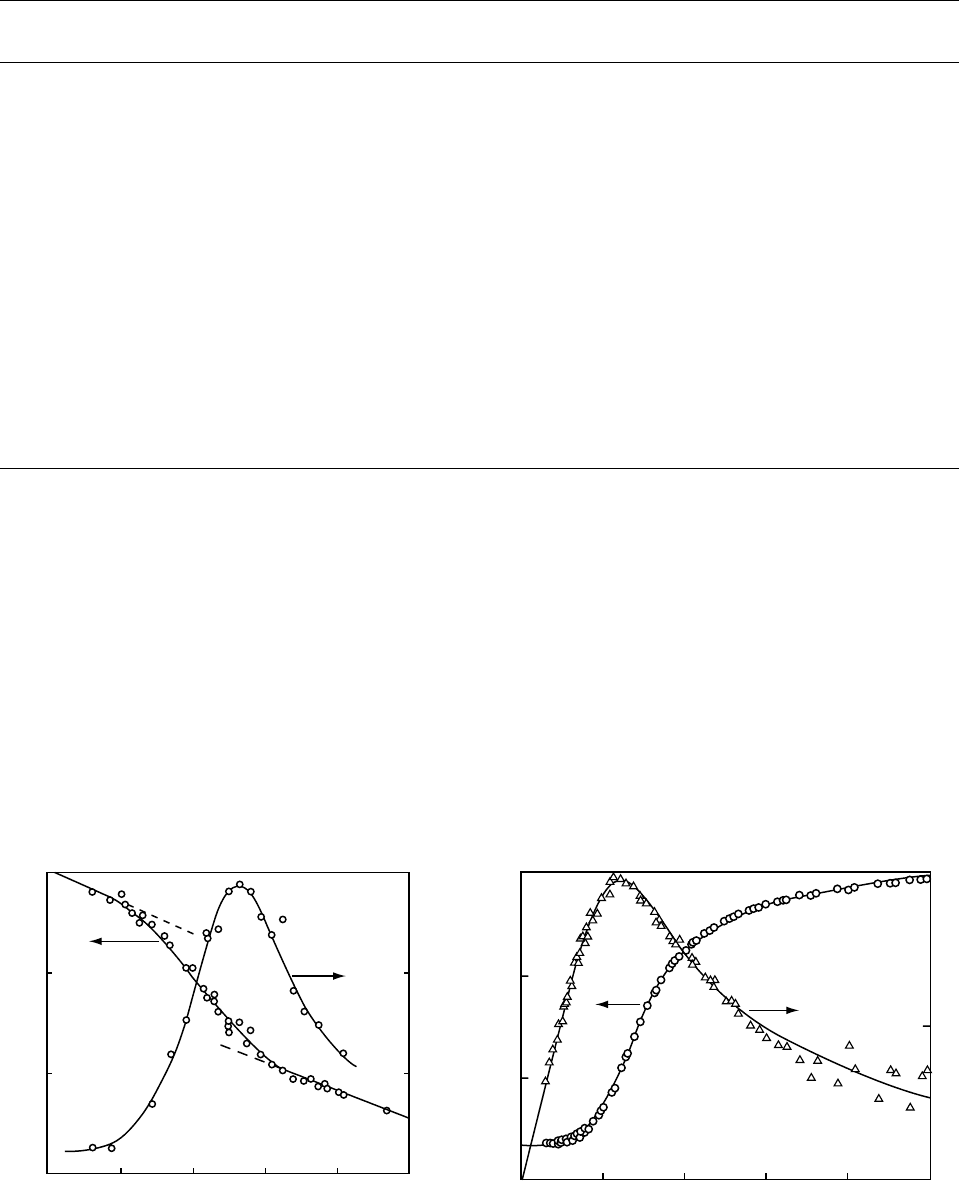
Polymers for Medical Ultrasonic Devices
The optimal polymer material for use in ultrasound med-
ical devices would have an impedance matching that of
human tissue, 1.5 MRayls, and minimal attenuation at the
frequencies of interest, which are typical between 5 and
10 MHz. Use of a material with a large impedance mis-
match against tissue results in reflection of energy at the
tissue/transducer interface, or more likely, the interface
between the coupling gel, which is often silicone or a hydro-
gel, and the device lens. A polymer with an impedance
mismatch and low attenuation can result in multiple
reflections within the subject and consequent reduction of
signal-to-noise in the image.
Hard, glassy, brittle thermoplastics such as polystyrene
(PS) and polymethylmethacrylate (PMMA) have low
attenuations, of order 6–10 dB/cm at 10 MHz, and in the
case of PS, a low acoustic impedance. Ductile polymers
such as polycarbonate (PC), many polyolefins and impact-
modified thermoplastics generally have high absorption co-
efficients, in the range 20–40 dB/cm. The same molecular
structures and mobility, which contribute to ductility, may
also contribute to absorption of ultrasonic energy. Not sur-
prisingly, rubbers and, by extension, any polymer above its
TABLE 60.2. Longitudinal and shear absorption coefficients for polymers at 25 8C & 2 MHz[1].
ra
L
a
S
Acronym Polymer (g=cm
3
) (dB/cm) (dB/cm) References
ABS Poly(acrylonitrile–butadiene–styrene) 1.02 1.8 15 [30]
Epoxy DGEBA/PDA 1.1844 6.3 36.1 [34]
Epoxy BGDE/PDA 1.179 21.0 — [37]
Nylon 6 Polycaprolactam — 13 — [41]
PC Polycarbonate 1.19 9.4 — [29]
PMMA Poly(methylmethacrylate) 1.19 1.4 4.3 [42]
PE Polyethylene 0.96 3.3 25 [42]
PE Polyethylene — 13 — [41]
PEO Poly(ethyleneoxide) 1.21 7.1 — [42]
PES Poly(ethersulfone) 1.37 5 — [29]
Phenolic 1.22 4.1 19 [25]
PIB Polyisobutylene 0.91 67 — [32]
PMP Poly(4-methyl-1-pentene) 0.84 1.4 6.7 [30]
PS Polystyrene 1.40 — — [41]
PS Polysulfone 1.24 4 — [29]
PU Polyurethane, polyether based 1.104 7.5 — [43]
PU Polyurethane, polybutadiene based 1.008 9.1 — [43]
PVC Poly(vinylchloride) — 8.1 — [41]
−60
1000
1500
2000
2500
−40 −20 0
Temperature (°C)
Longitudinal sound speed (m/s)
Absorption (dB/cm)
20 40
0
5
10
20
0
6
7
8
9
4812
log f (Hz)
log G(Pa)
16
Loss factor
20
−2
−1
0
FIGURE 60.5. (a) Sound speed and absorption vs. temperature for poly (carborane siloxane) and (b) log plot of shear modulus
and loss factor vs. frequency for polyurethane [1]. Reprinted from [1] Copyright 1996, with permission of Springer Science þ
Business Media.
ACOUSTIC PROPERTIES OF POLYMERS / 1027

glass transition temperature, are highly attenuating materials
at all frequencies. The requirement of impedance match,
low attenuation and reasonable mechanical properties
(strength, toughness, etc.) limits the choice of available
polymers for ultrasonic uses such as mammography com-
pression paddles. In this application polymethylpenetane,
a low-density polyolefin, has proven useful. This material
has impedance of 1.7 MRayls and an absorption coefficient
of 6 dB/cm at 10 MHz, and is a good compromise mechan-
ically between brittle materials used in ultrasonic lenses,
such as PS, and more ductile but highly absorbing polymers
such as PC.
Acoustic Emission
When subjected to stresses sufficient to initate and
propagate cracks, polymers emit sound waves with frequen-
cies ranging from the upper acoustic limit (ca. 10 kHz) to
10 MHz that may be detected with suitable transducers. A
well-isolated acoustic emission (AE) system may used to
detect deformation events including the slow to fast brittle
crack transition in PMMA, fatigue in SEN samples, and
crack propagation under high hydrostatic pressure [53].
Sono-Chemistry
Ultrasound has also been employed to accelerate chem-
ical reactions, including breakdown of polymers in solution,
and catalytic reactions [55]. Ultrasound is capable of pro-
ducing high local temperatures and pressures unlike any
other apparatus, and can drive unique chemistries as a result.
The principle mechanism is cavitation of the sonic agitated
fluid and the resulting bubbles collapse/explode at surfaces,
which in turn produce high velocity microjets of liquid. This
produces both physical and chemical changes.
An example of sono-chemistry is degradation of high
molecular weight PS and reaction of the low molecular
weight block with MMA monomer to produce a PS-
PMMA block copolymer [55]. Another example is surface
modification of Polyethylene using moderate oxidizing
agents to improve adhesion and wetability [55].
Ultrasonic Shear Rheology
Ultrasound can also be used to explore the viscoelastic
properties of polymers in film form. Alig et al. [56] describe
a shear rheometer operating in the range 1–40 MHz. on the
shear reflection principle. A shear wave is sent through a
quartz bar toward the interface between the bar and a poly-
mer film. The film alters both the amplitude and phase of the
reflected wave. The values of G’ and G’’ obtained when
plotted against offset temperature from T
g
(i.e., T T
g
),
show broader transitions at higher temperatures than those
obtained with low frequency mechanical DMA. One advan-
tage of the ultrasound method is that it allows DMA of
materials, which would be unsuitable for conventional
DMA, such as latex dispersions, gels, and mechanically
fragile films.
60.4 HYPERSONIC (GHZ) FREQUENCIES
Brillouin scattering measurements provide the velocity
and attenuation of acoustic phonons having frequencies in
the range of GHz and wavelengths of the order of 10
3
A
˚
[7]. Laser light of frequency v
i
and wave vector k
i
is
incident on the sample; the light interacts with the medium
and is scattered through an angle u. Phonons are absorbed or
emitted in the inelastic light scattering process governed by
the following energy and momentum conservation equa-
tions
v
s
¼ v
i
Dv,
k
s
¼ k
i
k,
(60:17)
where
k
s
and
kk are the wave vectors of the scattered laser
light and the phonon, respectively. Likewise v
i
and D
:
v are
the frequencies of the scattered light and the phonon.
The basic experiment consists of measuring the spectrum
of the scattered light. It consists of a strong elastic peak at
one frequency with additional components whose frequency
has been shifted by the inelastic scattering processes. The
frequencies of these much weaker phonon peaks are meas-
ured relative to the elastic peak. From observation of the
shifted Brillouin peak with respect to the central elastic
peak, the longitudinal Brillouin splitting, Dv
l
is given by
Dv
l
¼ kv
l
, (60:18)
where v
l
is the longitudinal phonon velocity with wave
vector k ¼ (4pn=l
i
) sin (u=2), n is the refractive index of
the material, l
i
is the wavelength of the incident light in
vacuum. The longitudinal sound velocity, v
l
depends on the
real part of the longitudinal viscoelastic modulus. It can be
expressed in terms of the longitudinal elastic modulus, M as
shown
v
l
¼
ffiffiffiffiffiffiffiffiffi
M=r
p
¼
ffiffiffiffiffiffiffiffiffiffiffiffiffiffiffiffiffiffiffiffiffiffiffiffiffiffiffiffi
(K þ 4G=3)= r
p
, (60:19)
where K is the bulk modulus and G is the shear modulus [8].
The line-width of the Brillouin peak measures the attenu-
ation of the acoustic phonon. The Brillouin peaks are pre-
dicted to have a half-width at half-maximum, G given by
G ¼
2
3
q
2
h
r
, (60:20)
where h is the longitudinal viscosity and G is measured in
hertz.
For linear PDMS, Brillouin scattering measurements on
two molecular weights of PDMS (3,800 and 68,000) by
Patterson et al. exhibited no measurable difference in the
phonon speed [9]. It was concluded that the asymptotic
1028 / CHAPTER 60
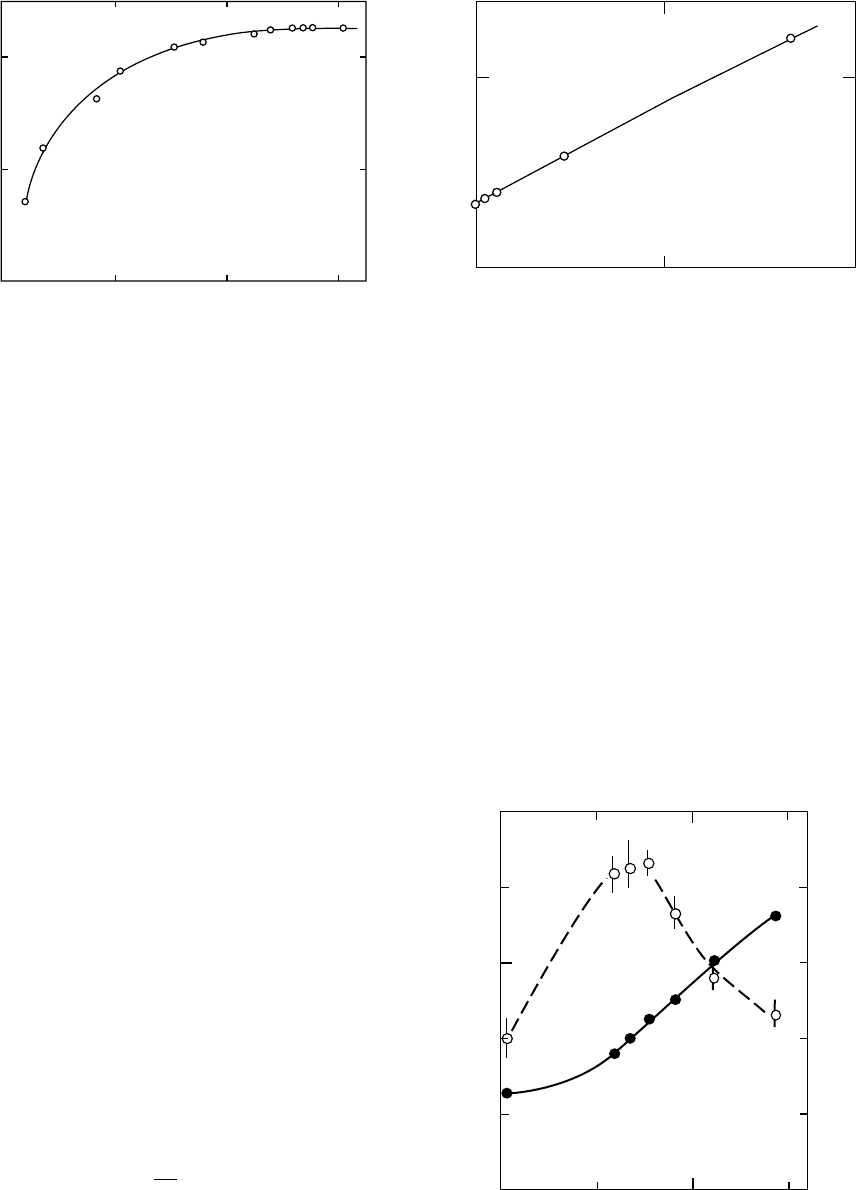
leveling of the phonon speed happened below the lower
number-averaged molecular weight of 3,800 g/mol. The
samples used in this case were highly polydisperse. Kumar
[10] and Kondo et al. [11] reported that the phonon velocity
in linear PDMS increased with increasing molecular weight
and had a tendency to level off in the region of higher
molecular weight of around 7,000 g/mol (Fig. 60.6 (a)).
For cross-linked networks, Lindsay et al. found the elastic
modulus M to increase linearly with increasing cross-link
density [12]. These were reported as preliminary results
carried out on networks formed by random cross-linking
using g irradiation. Kondo and Igarashi reported the phonon
velocity and modulus to increase linearly with cross-link
density for networks with four molecular weights prepared
by an addition reaction (Fig. 60.6 (b)) [11]. Kondo et al. also
reported measurements on end-linked networks that were
highly cross-linked and had much higher phonon speeds
[13]. Delides et al. [14] measured average values of 1,040
20 m/s, while Kondo and Igarashi reported values from
1,240 to 1,280 m/s. Wang et al. examined the effect of the
relaxation of longitudinal stress modulus on the propagation
behavior of the thermally driven acoustic wave in siloxanes
[17]. Patterson reported the hypersonic attenuation in
amorphous PDMS was studied as a function of temperature
and pressure [7]. Kondo et al. investigated Brillouin scatter-
ing from networks of end-linked dimethylsiloxanes to study
the hypersonic loss processes [13]. Figure 60.7 summarizes
their findings. Here the attenuation al
s
is defined as
al
s
¼ p
2G
n
p
, (60:21)
where a is the attenuation per wavelength. The x-axis has
been chosen as inverse of the number of skeletal elements
(2n þ 5) with n ¼ 1, 2, 3, 4, 5, and 6. This corresponds
to extremely highly cross-linked networks with M
c
¼ 274---
644 g=mol. The hypersonic attenuation attained a maximum
at n ¼ 4–6. The hypersonic frequency shows a steep de-
crease with increasing chain length and decreases by about
45%. Since the refractive index changes only by about 2%
for the different molecular weight samples, this would imply
a very dramatic change in the phonon velocity.
Brillouin spectroscopy can also be used to study the
change of sound velocity with deformation. Anders et al.
reported the longitudinal sound velocity in stretched poly
(urethane) and poly (diethylsiloxane) (PDES, Figure 60.8)
networks [15]. They used the lattice-model to determine the
force constants [11]. The samples showed different deform-
ation-dependent behavior of the force constants. For the
Molecular weight
Hypersonic velocity (10
5
cm/s)
10
2
0.8
0.9
1.0
10
3
10
4
10
5
0.0
V
s
(10
5
cm/s)
1.0
1.1
0.5 1.0
10<n
c
>
−1
FIGURE 60.6. (a) Phonon velocity in linear polydimethylsiloxane as a function of the molecular weight. (b) Phonon velocity in
rubbery PDMS as a function of cross-link density. Here n
c
is the average number of monomer units between cross-links and is
directly proportional to M
c
[11]. Reprinted with permission from Shingo Kondo and Takashi Igarashi, Journal of Applied Physics,
51, 1514 (1980). Copyright 1980, American Institute of Physics.
1.0
0.8
0.6
0.4
0.2
0
0
2
V
B
(GHz)
3
4
5
6
7
0.05 0.10 0.15
al
s
(2n15)
21
FIGURE 60.7. Phonon frequency (filled circle) and attenu-
ation (empty circle) in highly cross-linked rubbery PDMS as
a function of the number of skeletal elements. The hypersonic
attenuation attains a peak for n ¼ 4–6 [13].
ACOUSTIC PROPERTIES OF POLYMERS / 1029

diol-extended polyurethanes, the longitudinal sound velocity
increased in the direction of stress and decreased in the
direction perpendicular to it. The diamine-extended polyur-
ethanes showed anomalous behavior. While the sound vel-
ocity increased parallel to the stress direction as expected, it
also increased along the direction perpendicular to the stress.
For the PDES samples, they found in some cases no signifi-
cant variation of the sound velocity while in the other cases
they found the same anomalous behavior as observed in the
polyurethanes. Sinha et al. reported the molecular weight
dependence of the phonon speed for a series of nearly mono-
disperse PDMS networks [16]. They showed that, at
sufficiently low cross-link densities, the longitudinal phonon
speed in these networks approaches the speed in uncross-
linked high molecular weight PDMS liquids.
In comparing elastic constants measured ultrasonically or
from Brillouin scattering with those observed in a ‘‘static’’
(very low frequency measurement), it is important to note
that the ultrasonic/Brillouin values are adiabatic while static
values are isothermal. In elastomers, the acoustic response is
largely determined by the network structure introduced by
chemical cross-linking. The mechanical behavior at higher
frequencies (in the GHz regime) may have a very small
molecular dependence, depending on the frequency at
which the rubber–glass transition occurs for PDMS (Fig.
60.1). For PDMS networks [16], the change in modulus as
a function of cross-link density in equilibrium measure-
ments is considerably higher than that observed in Brillouin
scattering measurements (about 90% decrease in modulus
for M
c
¼ 4,000---40,000 g=mol in equilibrium measure-
ments). The decrease in speed for the same range of mo-
lecular weights was found to be about 75% using the low
frequency sound waves [5] compared to the 10% decrease at
the GHz frequencies [16]. At GHz frequencies, when a
stress is exerted in a particular place in the sample, the
distance over which relaxations can occur is very short.
The dependence of the modulus on the chain length between
cross-links is therefore much less compared to low fre-
quency measurements where there the time scales are
much larger and therefore the chains can relax over longer
length scales. At these frequencies, in Brillouin scattering
experiments, the sound wave propagation of a polymer
therefore depend primarily on the intermolecular potential,
which is a function of intermolecular separation and
hence volume. Thus there will be a change in the phonon
velocity whenever there is a change in any physical property
that affects volume, such as crystallinity, cross-linking, and
plasticization.
60.5 CONCLUDING REMARKS
In order to have a more complete understanding of the
acoustic properties of polymers, it is desirable to probe the
response over as wide a range in frequency as possible. In
the low frequency range (kHz), the propagation of an exter-
nally generated mechanical disturbance is used to measure
the acoustic properties. In the high frequency hypersonic
range (GHz), intrinsic thermal phonons using Brillouin scat-
tering are used to measure the acoustic properties. In the
ultrasonic (MHz) frequency range, which lies in between
these two limits, propagation of externally excited sound
waves is used to study amorphous polymeric medium. Col-
lectively, results from these different measurement tech-
niques can provide information about the mechanical
behavior of polymers over a wide range of time scales.
ACKNOWLEDGMENTS
The authors would like to acknowledgment the contri-
bution of Dr. Bruce Hartmann, now deceased, who was the
author of the chapter on acoustical properties published in
the previous edition of this handbook. Dr Hartmann’s com-
prehensive work provided the starting point for this article.
1
1300
1500
1700
PDES-45
draw ratio
sound velocity [m/s]
234
PDES-3
draw ratio
1600
1500
1400
sound velocity [m/s]
1234
FIGURE 60.8. Sound velocity of the longitudinal polarized phonon measured parallel (filled squares) and perpendicular (empty
circles) to the draw direction measured by Brillouin scattering. The samples are polydiethylsiloxanes with M
n
¼ 45,000 and 43,000
labeled as PDES-45 and PDES-3, respectively [15]. Reprinted from S.H. Anders, H.H. Krbecek, and M. Pietralla, J. Polym. Sci.,
Polym. Phys. Ed. 35, 1661-1676 (1997). Copyright 1997, with permission of Wiley-VCH.
1030 / CHAPTER 60
